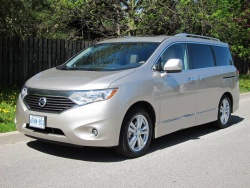 2011 Nissan Quest LE. Click image to enlarge |
|
Related links
Manufacturer’s web site |
Review and photos by Jil McIntosh
Photo Gallery:
2011 Nissan Quest
Sidebar:
Teaching an old dog new tricks
For the most part, the manufacturers that make minivans have stayed fairly true to their designs, with only gradual modifications. That’s not the case with Nissan. Its first Quest models were versions of Ford vans. When the “blue oval” left the minivan market, Nissan turned to its factory in Mississippi and built its own van, with a decidedly odd interior that the company redesigned a couple of years later to make it more mainstream.
The Quest left the Canadian market for 2010, but is back in its fourth generation. This time around, it’s made in Japan and is a version of a van called the Nissan Elgrand that’s sold overseas. Sitting near or at the top of the competitors’ price range, with oddball styling but with an interior that rivals some luxury sedans, it’s out to make its mark in a segment that has had its ups and downs but never entirely goes away.
It comes in four trim levels: the S at $29,998, the SV for $35,048, the SL at $38,798, and my tester, the top-line LE, which is $48,498 and was upped with a dual-pane sunroof on mine for another $2,000. That’s a lot of money. Comparing MSRPs, the starting price is topped only by Chrysler’s Town & Country, and by the base Toyota Sienna all-wheel drive. At the other end, among the highest trim levels, no other front-wheel-drive minivan costs more. If you load up a Grand Caravan to pretty much the same level of features, it’s $7,400 less than my tester.
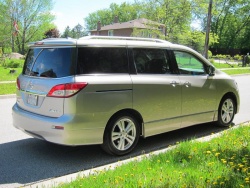 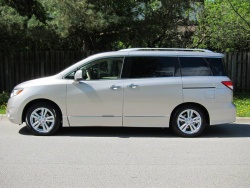 2011 Nissan Quest LE. Click image to enlarge |
It’s based on Nissan’s “D” Platform, which underpins the Murano and other models, and uses a 3.5-litre V6 mated to a continuously variable transmission (CVT), the only minivan on the market to use one. It’s exclusively front-wheel drive: Toyota makes the only minivan with an all-wheel option. The V6 makes 260 horsepower and 240 lb.-ft. of torque, which puts it about mid-pack with its competition: Toyota’s four-cylinder makes 187 horses, while Honda Odyssey’s V6 makes 248. Chrysler’s minivan siblings – Dodge Grand Caravan, Chrysler Town & Country and the Volkswagen-badged Routan – top the list at 283 horsepower.
I have no complaints about the engine, which feels strong and with smooth acceleration. The CVT is a pleasant surprise, too. These gearless transmissions can sometimes produce an unappealing driving experience, but this one is perfectly suited to the vehicle. But the suspension is mushy and soft and the steering is light. That may well appeal to a large number of drivers, who will interpret it as a luxury feel – and there’s nothing wrong with that if they do. Those who like a little more road feel will find the Quest to be squishy over bumps, and there’s a lot of lean in the corners.
Nissan’s not afraid to go out on a limb with its styling ventures – witness the Cube and Juke – and the Quest is no exception. Each to his or her own, of course, but I don’t really want to see this van in the swimsuit competition. A graceful curve along the side is the sole saving grace alongside its angular nose and big square butt. The high beltline and short windows help to make it look like the biggest on the block, but it’s actually shorter and narrower than most of the competition (you can expect some visibility issues thanks to that smaller expanse of glass, too). It’s the tallest, though, towering anywhere from 43 to 129 mm over its rivals. Even so, Nissan claims that a unique sliding door rail system gives it the lowest step-in height of all vans, which can be important for small children or elderly passengers who may have trouble getting up into a higher one.
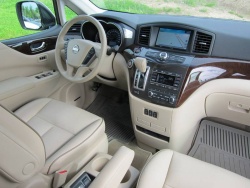 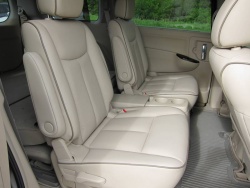 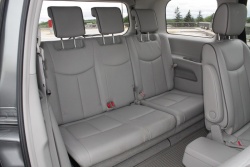 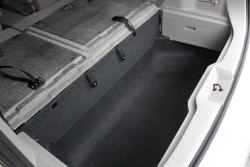 Top two photos: 2011 Nissan Quest LE; bottom photos, Quest SL, by Chris Chase. Click image to enlarge |
The offbeat exterior is wrapped around a far more conventional interior that’s one of the best-looking of the bunch. I wouldn’t want my tester’s beige carpets for daily family use, but my “Café Latte” leather seats sure look good (the other choice is grey). I could see taking this van, with its comfortable seats and thickly-padded armrests, on a road trip. The second-row seats are equally pleasant; the third row seats are flat, as they usually are, but they’re very easy to access, and substantial foot room under the second row gives passengers back there enough space for their legs. The Quest is strictly a seven-passenger van, since the second-row captain’s chairs can’t be swapped for a bench seat.
They can’t be removed, either. If you want to carry cargo, the second- and third-row seats fold forward, as they do on an SUV, to provide a flat floor. In most vans, the third row can be folded backwards into a well in the floor, and the second row can be taken out or, in Chrysler’s case, folded into the floor. This means the Quest has less overall cargo volume, although there’s still a lot of room, and it will probably only be a problem for those bringing home, say, a new refrigerator. What I really like about the configuration is that since the third row doesn’t flip backwards, what you’ll find behind it is a huge “trunk” hiding under the cargo floor. You can store items completely out of sight, and if you do need to fold the seats, everything can stay in there, since that space isn’t required for third-row stowage.
As is common with Nissan, the driver’s controls are simple and easy to use, even on my tester’s navigation system. What isn’t as simple is reaching them: the gearshift lever sticks out of the dash and is directly in the way. I found I was taking my eyes off the road too much to make sure I was reaching around and locating the correct button.
The entry S trim level contains air conditioning, first- and second-row power windows, cruise control, keyless entry with pushbutton start, removable second-row console, cloth seats, stereo with auxiliary jack, and 16-inch steel wheels. Moving up the trim ladder adds such things as 18-inch alloy wheels, tri-zone automatic climate control, rear-view monitor, Bluetooth, an iPod connector and leather seats. Exclusive to the LE are an advanced climate control system with odour eliminator, rear audio controls, navigation system, power-operated third-row seats (to raise them back up to a sitting position when they’re folded), second- and third-row sunshades, blind spot warning system, driver’s side memory, xenon headlamps, and a Bose stereo and rear-seat DVD system that can be optioned on the SL trim.
Common to all trim lines is a neat little feature tied in to the standard tire pressure monitoring system. When you put air in the tires, the horn will beep when you reach the correct pressure.
Where this newest Quest will end up in the minivan wars has yet to be determined, and it falls to such extremes that I’m hesitant to guess. Price-wise it’s up there with its Japanese competitors, but with a less-than-mainstream appearance. It’s more luxurious inside than its domestic and Korean contenders, but they don’t cost as much. I can’t see Nissan slicing off more than just a thin wedge of the segment with this fourth-generation Quest, but it won’t be for lack of trying.
|
Pricing: 2011 Nissan Quest LE
Specifications
Competitors
Crash test results
|











